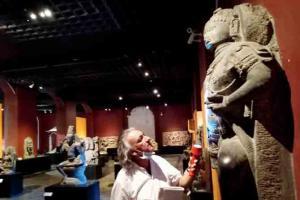At a time when precious art and invaluable artefacts can't be tended to, what are the city's museums and galleries doing to safeguard heritage which we cannot afford to lose?

Anupam Sah, head conservator, CSMVS, examines a sculpture under torchlight. Together with a small team, Sah is living on site to monitor the collections during lockdown. Pic courtesy/ CSMVS
Anupam Sah finds it telling that the need of the hour, for both humans and precious pieces of art, is conservation and prevention. Together with a critical team and security personnel, Sah, who is head conservator at the Chhatrapati Shivaji Maharaj Vastu Sangrahalaya (CSMVS), has been living on site, watching over its invaluable collections. "We have something called the Risk Assessment Protocol that was implemented when we realised the health crisis was mounting. This was more was than a week before the national lockdown was announced. We had planned early, and that helped."
By mid-March, the museum's director Sabyasachi Mukherjee, who has his residence on the property, chaired a series of meetings to assess the situation and identify risk factors. The protocol began with securing the perimeters of the museum and identifying the staff that had agreed to live on site. The museum's galleries were given a clean-up, electrical units and climate control units checked. Ongoing restoration of the museum building was stopped in phases, and locks were changed in some sections of the building. A few priority items and artefacts were moved to the higher security area.
ADVERTISEMENT

The Sir JJ School of Art Pottery showcase on the first level of Byculla's Dr Bhau Daji Lad Museum carries silica gel in bowls to absorb moisture
Half-an-hour away in Byculla, inside the city's oldest museum—Dr Bhau Daji Lad City Museum (BDL)—a different approach was adopted to protect the collections. "When we had restored the museum in 2007, museum expert Vinod Daniel had come on board. Having worked on temperature related issues and collection maintenance, he assured us that the heritage building and its exhibits didn't require air-conditioning," says Tasneem Mehta, of the 163-year-old magnificent colonial structure. Mehta, who is managing trustee and honorary director at BDL, shares that Daniel suggested this because Mumbai experiences stable temperatures all year through with marginal variations, compared to say, Delhi. Which was a good thing. The problem was humidity. "All our airtight vintage wooden display cases hold inside them silica gel bowls to ensure moisture in the atmosphere is absorbed and humidity levels are in check. The newer cases have in-built temperature control. Ninety per cent of our objects are in good shape. We knew this [lockdown] was going to happen, and took ample care," she says. BDL is also home to the Mumbai office of The Indian National Trust for Art and Cultural Heritage (INTACH), a non-profit that conserves heritage with the belief that living in harmony with heritage can enhance the quality of life. Here too, sensitive artefacts were locked in the company of silica gel.
Back at CSMVS, when the museum was sealed, they tweaked climate control settings to between 24 and 25 degrees Celsius, "because, in case humidity increases due to unforeseen heavy rain, the risk of condensation can be obviated due to the higher setting." Mukherjee says that the team is monitoring the health of the collections with a hawk eye. As per their established strategy, they have adopted the preventive conservation method.

Kalpana Shah with daughter Sanjana at Worli's Gallery Tao Art Gallery. Since their residence is in the same building as the gallery, weekly checks on the inventory have been possible. Pic/ Atul Kamble
Temperature and humidity is also what the city's top art galleries factored in before shuttering for the lockdown. "It's fundamental to have an automated system in place that ensures climate control carries on. A month of lockdown will not affect us," believes Ashvin E Rajagopalan, director of Piramal Museum of Art.
Worli art gallery Tao's Kalpana Shah and daughter Sanjana had to consider the safety of over 2,000 works in their inventory. "The temperature and humidity in the stockroom continues to be controlled and the collections are safe from sunlight," says Sanjana, sharing that the temperature is currently maintained at a cool 20-22 degrees Celsius, the same as when the gallery was operational.

Tasneem Mehta, Dr Bhau Daji Lad Museum
Nature comes into play at many levels, more so at the well-ventilated CSMVS building whose wide airy corridors house ancient sculptures. "We do a thorough physical check of the condition of the art collection every day because when visitors are away, the chance of recolonisation by microorganisms is high. We cover one section daily. The most virulent deteriorant is dust because it carries all fungal and chemical pollutants that can affect objects, but since the sealing of the museum and restriction on movement, there is negligible amount of dust, which is wonderful to see," says Sah, citing the lack of people and vehicular pollution as the main reasons. "Most collections were made centuries ago in a period that saw far less pollution and population. It must be like a flashback for these objects, I imagine!" he laughs.

Priyasri Patodia, Priyasri Gallery
At Worli's Priyasri Art Gallery, dehumidifiers have been installed in the storage area. Founder Priyasi Patodia says they are fortunate to have an in-house caretaker watch over the collection. Since the Shah family lives in the same building where Tao is housed, weekly checks on the inventory are possible. "However we did a final clean-up before the lockdown and froze all sales and movement. We re-packaged the more fragile works of mixed media that use thread, wood, and the oil works, that require more care. Our ongoing exhibition that celebrated the gallery's 20th anniversary remains on display [visible from the street below through the trademark, ceiling high windows], which we are monitoring," says Sanjana.
Owner of Pundole Art Gallery, Dadiba Pundole admits that the lockdown caught him unaware. "Luckily, unlike museums, galleries deal with contemporary art where materials are stable; circulation of air and pre-set temperature levels should ensure the artworks are in good health." Fellow gallerist Pravina Mecklai is also relieved that the collection at Colaba's Jamaat is in good shape, with a staffer going across whenever possible for a quick check.
 Ashvin E Rajagopalan, Piramal Museum of Art
Ashvin E Rajagopalan, Piramal Museum of Art
While both, BDL and CSMVS have partnered with Google Arts and Culture, making their expansive collections available for viewing online, for some like Tao, if the lockdown extends to the next month, the Shahs will have to strip the gallery walls and move the works to the stock room.
Sah believes that like so many others who are making the most of the time they have on hand, it's important that his team engages in self and knowledge improvement. The team is using the time to study digital data and treatment records from their 10-year-old archives. "We will also observe patterns of conservation. Other departments of CSMVS are using this period constructively too," he says, "It's a happy place; the morale is high. We are getting to know each other better."
Humidity buster
Silica gel can protect exhibits containing ivory, wood, textiles or paper (organic) for up to a month. In case of inorganic materials like metal, since they expand and contract due to heat changes, the silica gel needs to replaced less frequently.
Risk factors
Textiles and wood
Insects
Paper and leather
Fungus
Bronze objects high
Humidity
Catch up on all the latest Mumbai news, crime news, current affairs, and a complete guide from food to things to do and events across Mumbai. Also download the new mid-day Android and iOS apps to get latest updates.
Mid-Day is now on Telegram. Click here to join our channel (@middayinfomedialtd) and stay updated with the latest news
 Subscribe today by clicking the link and stay updated with the latest news!" Click here!
Subscribe today by clicking the link and stay updated with the latest news!" Click here!







